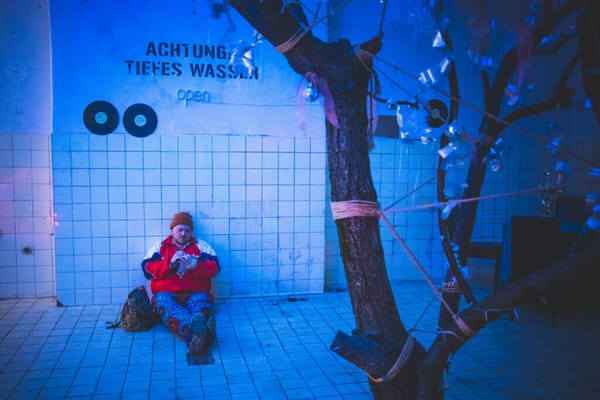Solving secret puzzles at the Japanese mystery school
Alanna Yeo talks nazo, design cultures, and her unique ARG-style experience at Nazogaku.

One of the best parts about running a games website is that you get to explore just how big the idea of games and plays can be. Normally, we wouldn’t write about escape rooms, but what if it was an escape room where there was no room per se and you weren’t trying to escape? What if it was just a puzzle out there in the world that you solved with your friends? What if the puzzle had a story and solving it was both a way to understand the story and participate in it?
In Japanese, "nazonazo" means riddle, and the shortened form, "nazo", means mystery or enigma — something you solve or something unsolvable. Nazogaku (roughly “mystery school”) is one of many events in Japan dedicated to puzzle-like games where players move around spaces and find answers. This was its 13th year, and if the website is to be believed, its last. There’s some mystery to the event itself. The theme for this year is “nazo is banned”, which led to a series of games that either hid their identity as games or broke all the conventions for what a puzzle game could look like. It wasn’t just a theme, though. The event had an overarching ARG-style element — an evil organizing committee had taken over and was intent on controlling the flow of information and the need for subversive games to get around their censorship.
Singaporean designer Alanna Yeo was one of the 36 exhibitors at this year’s Nazogaku, which took place on November 2nd in a hospital building in Fujimi, about 30 kilometres from Tokyo. Yeo has designed a clutch of small TTRPGs like the journaling game Whisk & Wonder: Tales from a Magical Bakery and Cryptid Spotting, which is a little notebook where players draw and write about local monsters they might see around their city. But her practice Thorn and Key focuses primarily on “immersive experiences” — games built around spaces but more puzzle than larp. Yeo’s game was a collaboration with Chikako Omura, a reviewer for Escape the Roomer, who has played more than 200 of these kinds of games all across the world.
Rascal sat down with Yeo to talk about what nazo means, her experiences presenting a game at Nazogaku, and the differences in the conventions of puzzle design between English and Japanese speaking audiences.
This interview was edited for length and clarity.
Thomas Manuel: How did you hear about Nazogaku?
Alanna Yeo: So, when I was in Japan earlier this year [for Game Market], I was put in contact with an escape room reviewer who writes reviews for this website called Escape the Roomers. They have writers or guest writers that are all escape room enthusiasts, so they play escape rooms all over the world, and then they submit reviews. I was put in touch with [Chikako Omura], and we got along, we played a few games together, and she asked me if I would like to go to Nazogaku. She introduced Nazogaku to me, and she volunteered to be my Japanese liaison, so she was basically the contact point for all the Nazogaku emails and stuff like that.
Manuel: Tell me a little bit about the kinds of games that were showcased there.
Yeo: I think this is also probably the right juncture for me to delve a little bit into the Japanese culture for puzzle games. When we talk about escape rooms for the western side, a lot of people imagine it to be kind of like a studio setup. You go into a room, you are literally locked in, and then you solve a series of puzzles within that confined space in order to get out of that room. This is also the case, or rather, this is part of what escape games in Japan means.
Japan has developed its own culture for this sort of puzzle and escape rooms. Or rather, they're also very developed in something I call puzzle trails. I think the term differs in different regions. The concept is that you maybe pick up a leaflet or a slip at a starting location, and then you walk around the city, and then you do puzzles along the way related to landmarks that you see. So it's a nice way to explore the city, see things that you don't necessarily see, as well as engage in some actual, like, brain-teasing activity.
I've played some very unique puzzle trails in Japan. For instance, the Tokyo Metro: If you know the metro system, every year Tokyo Metro has a nazo game. You buy a ticket from Tokyo Metro, and it comes with the game kit as well as a day pass. I think the last time I played it, I spent around five hours just traveling around the city on the Tokyo Metro, playing, solving puzzles around the city. And I saw people of all demographics playing. Little kids playing, couples playing, elderly folks playing. The culture embraces puzzles, and nazo, as we call it, here.
For this particular Nazogaku, the setup was slightly different. The committee said that for this Nazogaku, nazo is banned. So, if you take it at face value, it means that no typical nazo is allowed, but it's actually about hiding puzzles in plain sight. I think that's what a lot of groups did. Like, they hid puzzles in plain sight, or they did some improv show, which resulted in a puzzle somewhere, or they had to do some sort of immersive theater hunt where a mystery was also being solved.
Manuel: So nazo as a word means something more than a puzzle…
Yeo: It's a puzzle, riddle, mystery. It's hard to get a single English word.
Manuel: As soon as you say riddle or mystery, I'm like, oh yeah, the thing that people who don't play games also like. Whereas if you say puzzle, I'm like, oh, a thing that only people who like puzzles like… Can you talk about what you presented at the convention?





